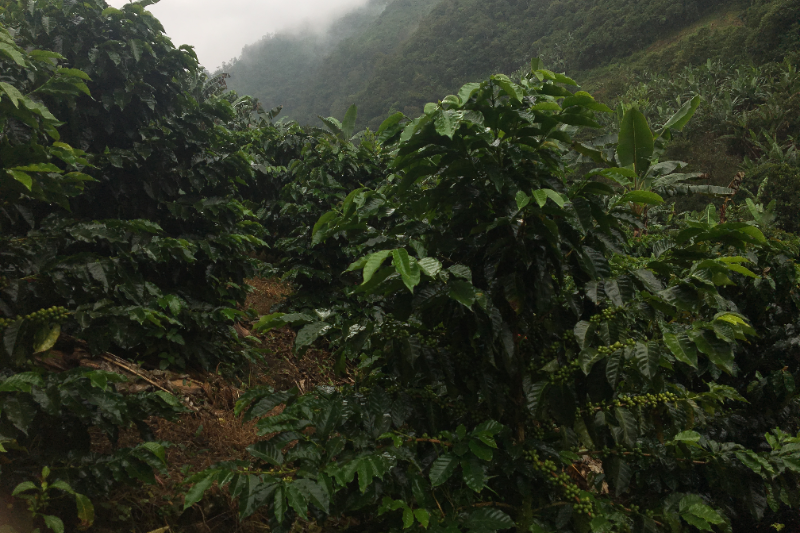Coffee prices end 2022 on a stable note

Image courtesy of Caravela Coffee
The International Coffee Organization announced that coffee prices start 2023 on firm footing as prices close calendar year 2022 on an even note.
The ICO Composite Indicator Price (I-CIP) gained 0.3% from November to December 2022, averaging 157.19 US cents/lb for the latter, whilst posting a median value of 157.73 US cents/lb. In December 2022, the I-CIP fluctuated between 151.95 and 162.31 US cents/lb.
Average prices for all group indicators remained stable, with a slight increase in December 2022. The Colombian Milds, Brazilian Naturals and Robustas increased by 0.4%, 1.5% and 1.3%, respectively, month on month in December 2022. The group indicators respectively averaged 224.12, 169.00 and 93.76 US cents/lb in December. The Other Milds fell by 1.7% to 210.24 US cents/lb. Stability in the market is in part due to the average of the 2nd and 3rd positions of the ICE New York and London futures market remaining stable.
The Colombian Milds-Other Milds differential sprung back up 48.2% to 13.88 US cents/lb. The Colombian Milds-Brazilian Naturals and Other Milds-Brazilian Naturals both declined by 2.8% and 12.8% to 55.12 and 41.24 US cents/lb in December 2022, respectively. The Colombian Milds Robustas differential remained stable, losing only 0.2 percentage points and reaching 130.36 US cents/lb for the last month of 2022. Falling 3.9% over the course of the month was the Other Milds-Robustas differential, retracting 3.9%, to 116.48 US cents/lb. The Brazilian Naturals-Robustas differential gained 1.8% from November to December 2022, reaching 75.24 US cents/lb. The arbitrage between the New York and London Futures gained 0.2%, closing in at 82.26 US cents/lb in December 2022, up from 82.13 US cents/lb in November 2022.
Intra-day volatility of the I-CIP decreased 0.2 percentage points between November and December 2022, reaching 9.1%. Robustas and the London futures market were the least volatile amongst all group indicators, at 5.3% and 4.8%, respectively, in December 2022. The Brazilian Naturals’ volatility was the highest amongst the group indicators, averaging 12.1%, a 0.2 percentage point increase from the previous month. The variation in volatility of the Colombian Milds and Other Milds for November to December 2022 is 0.6 to 11.6% and 0.1 to 9.7%, respectively. The New York futures market remained the most volatile, averaging 12.5% for the month of December 2022.
The New York certified stocks increased by 46.6% from the previous month, closing in at 0.87 million 60-kg bags, whilst certified stocks of Robusta coffee reached 1.08 million 60-kg bags, representing a decrease of 25.5%.
Exports by Coffee Groups – Green Beans
Global green bean exports in November 2022 totalled 9.21 million bags, as compared with 8.31 million bags in the same month of the previous year, up 10.8%. The positive growth was driven by the Brazilian Naturals and Robustas, which saw their exports increase by double digits, while the Colombian and Other Milds suffered from double-digit decreases. As a result, the cumulative total exports of green beans for coffee year 2022/23 bounced back into black, up 3.5% as compared with the 3.5% decrease for the first month of the current coffee year. The cumulative total for 2022/23 to November is 17.63 million bags as compared with 17.03 million bags over the same period a year ago.
Green bean exports of the Brazilian Naturals bounced back sharply in November 2022, rocketing up by 34.5% to 3.67 million bags, following a lackluster 0.5% increase in October 2022 as compared with the same periods in the previous coffee year. For the first two months of coffee year 2022/23, green bean exports of the Brazilian Naturals amounted to 7.11 million bags, up 15.6% from 6.15 million bags over the same period a year ago. Not surprisingly, the shifting fortunes of the Brazilian Naturals reflected the changes in Brazil’s green bean exports, the biggest producer and exporter of the Brazilian Naturals, which also bounced back in November 2022 (up 32%) as compared with October 2022 (up 1.9%).
Green bean exports of Robustas amounted to 3.58 million bags in November 2022, as compared with 3.17 million bags in November 2021, up 12.9%, a sharp turnaround from the 5.5% decrease in October 2022. This meant that the shipments in the first two months of coffee year 2022/23 were up 4% to 6.38 million bags versus 6.13 million bags in the same period in coffee year 2021/22
Shipments of the Other Milds decreased by 15.1% in November 2022 to 1.1 million bags from 1.29 million bags in the same period last year. This is the second consecutive month of negative growth for green bean exports of the Other Milds since the start of the new coffee year, having already fallen by 7.1% in October 2022. As a result, the cumulative volume of exports fell by 11% in the first two months of coffee year 2022/23 to 2.36 million bags from 2.65 million bags over the same period in coffee year 2021/22.
Exports of the Colombian Milds decreased by 22.8% to 0.86 million bags in November 2022 from 1.12 million bags in November 2021, driven primarily by Colombia, the main origin of this coffee group, whose green bean exports were down 26.7% in November 2022. As a result of the sharp downturn, exports of the Colombian Milds from October to November 2022 were down by 15.2%, at 1.78 million bags, as compared with 2.1 million bags in the first two months of coffee year 2021/22.
Exports by Regions – All Forms of Coffee
In November 2022, South America’s exports of all forms of coffee increased by 4.7% to 4.96 million bags. There were wide variations in the performances of November 2022 exports among the major origins of the region, with Brazil (up 25.4%) being the best performing, and Peru (down 41.5%) and Colombia (down 24.2%) the worst performing. Improved shipping conditions have been reported as the reason behind the strong increase in Brazil’s exports, but for Peru and Colombia the sharp downturns are linked to local production conditions. Persistent bad weather linked to the La Niña phenomenon has caused Colombia’s November 2022 coffee output to drop by 6%, the country’s third consecutive month of negative growth, with a consequent impact on exports. In Peru, irregular weather patterns have led to prolonged and intermittent rains, which impacted the regular development of cherries and flowers, leading to coffee trees having both cherries and flowers concurrently and thus spreading out the harvesting period. Moreover, intermittent rains also hampered the drying process, having a negative impact on the quality of dried beans. These all affected the supply of coffee beans and contributed to November 2022 having the lowest volume of exports since 2007, when only 244,325 bags were shipped from Peru.
Exports of all forms of coffee from Asia and Oceania increased by 19% to 3.78 million bags in November 2022 and were up 3.6% to 6.57 million bags in the first two months of coffee year 2022/23. The region’s sharp increase is explained by Vietnam (up 19.8%) and Indonesia (up 48.7%), the largest and the second-largest producers and exporters of coffee from Asia and Oceania, shipping 2.2 million bags and 0.89 million bags, respectively. However, the region’s third-largest exporter, India, saw its exports decrease in November 2022, down 0.8% to 0.58 million bags from 0.59 million bags in November 2021.
Exports of all forms of coffee from Africa increased by 6.8% to 1.09 million bags in November 2022 from 1.02 million bags in November 2021. For the first two months of the current coffee year, exports totalled 2.16 million bags as compared with 2.15 million bags in coffee year 2021/22. In November 2022, Uganda’s exports fell for the 11th consecutive month, decreasing by 14.8% to 0.45 million bags from 0.52 million bags in November 2022. Uganda’s cumulative total exports over the past 11 months (January–November 2022) amount to 5.21 million bags as compared with 6.23 million bags over the same period a year ago (January–November 2021), down 16.4% or 1.02 million bags. Drought in most of the coffee growing regions, leading to a lower and shorter main harvest season in central and eastern parts of Uganda and hence lower output, is continuing to hamper Ugandan coffee exports. Despite Uganda’s large negative push downwards on Africa’s coffee exports in November 2022, positive pulls upwards by Côte d’Ivoire (up 111.1%) and Ethiopia (up 29.2%), the region’s third- and second-largest producers and exporters, supported by Kenya (up 16.6%) and Rwanda (up 63.6%), were sufficiently robust to ensure that the region’s exports grew in November 2022, despite the downturn in Uganda’s exports.
In November 2022, exports of all forms of coffee from Mexico and Central America were down 7.1% to 0.41 million bags as compared with 0.45 million in November 2021. For the first two months of the current coffee year, exports are down 13.3%, totalling 0.89 million bags as compared with 1.02 million bags in October–November 2021/22. The region’s decline in November was due to Honduras, down 50%, which is struggling with leaf-rust, or roya, which has hit the industry’s harvests.
Exports of Coffee by Forms
Total exports of soluble coffee decreased by 3.2% in November 2022 to 0.97 million bags from 1.0 million bags in November 2021. In the first two months of coffee year 2022/23, a total of 1.81 million bags of soluble coffee were exported, representing a decrease of 12.9% from the 2.07 million bags exported in the same period during the previous coffee year. Soluble coffee’s share in the total exports of all forms of coffee was 9.0% (measured on a moving 12-month average) in November 2022, down from 9.1% in November 2021. Brazil is the largest exporter of soluble coffee, shipping 0.27 million bags in November 2022, followed by India with 0.19 million bags and Indonesia with 0.15 million bags exported over the same period.
Exports of roasted beans were down 7.5% in November 2022 to 68,865 bags, as compared with 74,411 bags in November 2021. The cumulative total for coffee year 2022/23 to November 2022 was 130,953 bags, as compared with 149,108 bags in same period a year ago.
Production and Consumption
The latest provisional estimate for total production in coffee year 2021/22 remains unchanged at 167.2 million bags, a 2.1% decrease as compared to 170.83 million bags in the previous coffee year.
World coffee consumption is projected to grow by 3.3% to 170.3 million 60-kg bags in 2021/22 as compared to 164.9 million for coffee year 2020/21. In 2021/22, consumption is estimated to exceed production by 3.1 million bags.
For the full report, visit: ico.org.



